Amherst History Month By Month: Buildings And Our Public Safety
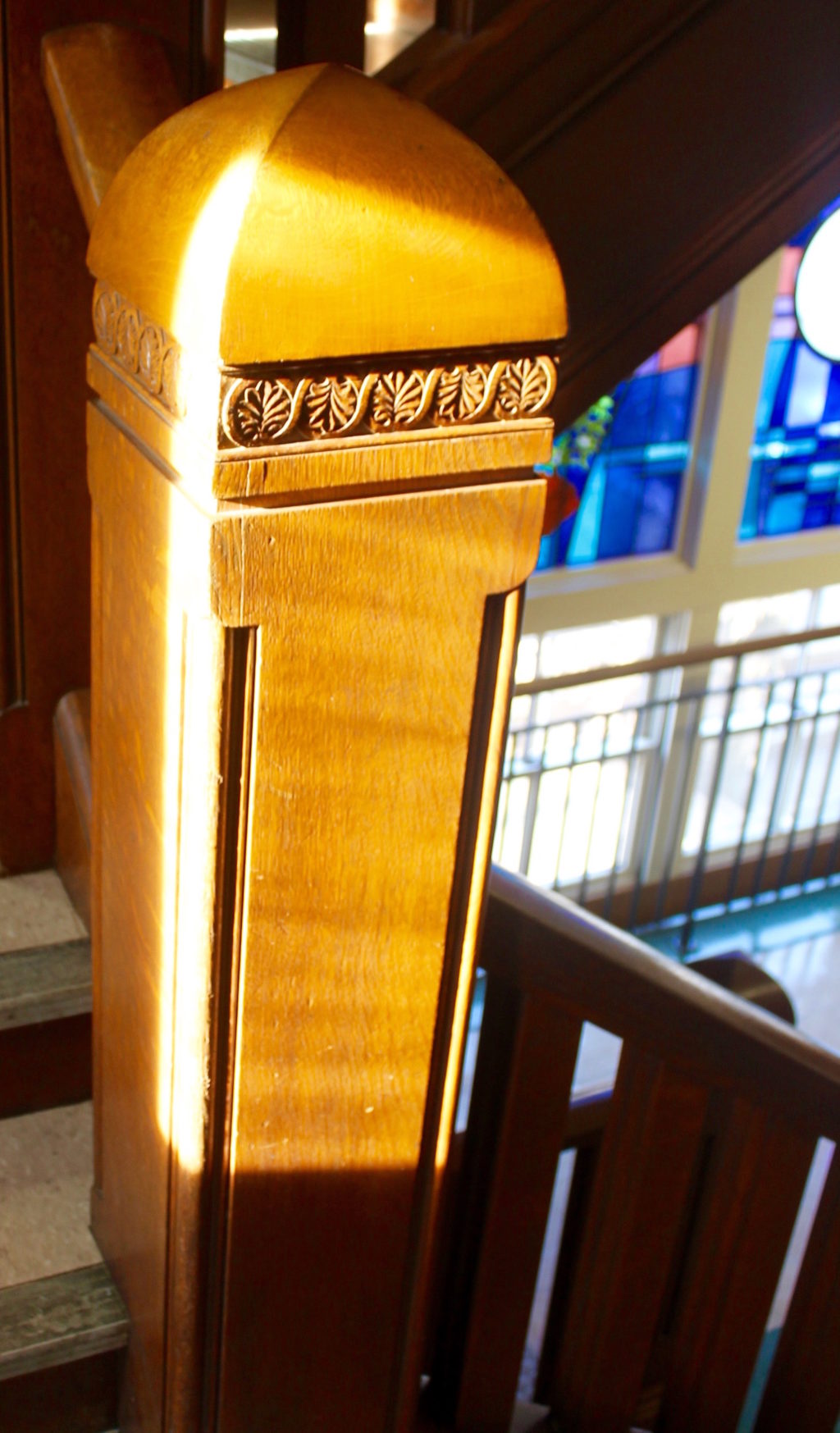
Town Hall stairwell. Photo: Willy Drake
This month’s column is about Amherst’s public service buildings such as the fire, police, and public works departments because our town is currently pursuing four large capital projects, two of which are set aside for 1) a new Central Fire Station and 2) a new Public Works department. Town Hall is managing these deliberations and you may already know, the DPW’s current headquarters is on South Pleasant St, housed in an old brick trolley barn.

The Central Fire Station is on North Pleasant St near to our Amherst center CVS. It has outgrown current accommodations for our town’s needs but is a handsome building that should be preferably preserved.
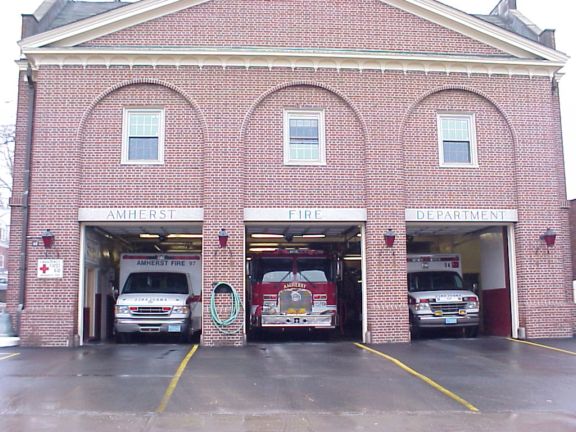
I started counting all the services that have become a part of our town government’s responsibilities over the centuries and it made me a bit tired listing it all: street lighting, safe drinking water, sanitation and waste disposal, (all public health issues, not counting the Covid-19 pandemic), trash and snow removal, parks, recreation, and open space; police and fire, housing; local town government functions (such as parking, permitting, and licensing, etc.), voting and public education, arguably the most important for a thriving republic and functioning democracy. Activities and/or programs mandated by the state or the federal government that govern our town’s institutions are also involved if receiving public funding. I have probably inadvertently left some out so check out the town website (insert here). Personally I will never forget Town Hall offering free homemade (beautiful) cloth masks at the start of the pandemic and being all over vaccines as soon as they were available for denizens of Amherst. All of these programs contribute in one way or another to define what living in Amherst means to each of us, whether or not they are housed in historic buildings – but in our town.
In the case of our fire and police departments, services have slowly coalesced into institutions although we each of us have a different sense of how we value them, especially the police department, depending on our interactions with them over time. While they are now both distinct departments that have their own buildings, the police department was historically managed from within the handsome building that is Town Hall, designed around 1890 by Henry S. Mackay (his dates are 1860/61-1948) and built by Concord, NH-based builders Mead, Mason and Company, by 1889. They specialized in construction of churches and public buildings. It was therefore not until the late 19th century that Amherst created a specific place that defined the town’s civic identity as distinct from its long established educational significance, (meaning Amherst College and the state’s new (then) flagship university campus on its northern edge.)
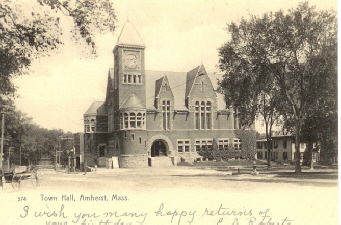
Colder temperatures and fossil-fuel based utility bills (that only continue to go up!) remind me these days that winter is a risk for domestic fires. Historically, the risk was keenly felt in the late 1700s and early 1800s in rural areas when the provision of fire buckets or placing buildings near reliable sources of water were good prevention strategies in the absence of a coordinated town response to the outbreak of fire. Instead, church bells were often rung to sound the alarm. Amherst’s fire services begin in earnest after a particularly tragic fire in 1838 and other “excessive conflagrations.” Privately owned fire ‘apparatus’ such as Cataract engines, hooks, ladders, and enough hose to make a difference to put out the flames were acquired and some supplies were stored in Elijah Boltwood’s Inn (now 30 Boltwood). The town’s fire department records are logged in beautiful handwritten copperplate writing in the same book as the Hampshire Rangers Rifle Company until 1845, and then continue, separately, to the present day.

In the case of our town’s response to policing and public safety provision, local history suggests it was a result of the expressed need, first, for a town night watchman. (Look here for a talk on the history of policing in Amherst from the Amherst Historical Society) At the same time, some meeting houses were used as places to lock up ammunition and firearms, if needed. Mr. Fiske A. Thayer, of Leverett, was hired as town night watchman and he soon also served as lamplighter, firing the gas burners for downtown street lighting in the middle to late 1800s. Even before the distinctive red call boxes that sounded the alarm before our present emergency dispatch system, our small police office functioned out of the basement of town hall with a three cell lock up. Homelessness and “our outside poor” were then concerns as now but then, when ‘we/they’ were termed “vagrants” we were often locked up in these cells. The national context for the forming of police departments across the country grew during the Civil War and is influenced by the urban patrols at the time acting against enslaved populations (although I have not verified any in Amherst, they existed in many cities.) Our town’s police reports begin in the 1870s.
Amherst’s first timber framed fire station stood on North Pleasant Street. It was built in 1860 and razed in 1930 to make way for our current Central Fire Station. After 1915, the police officers moved out of Town Hall and operated out of a lockup that was a two-story brick building in the rear of the fire station. In this photo, there are 1920’s era automobiles parked in the street in front.
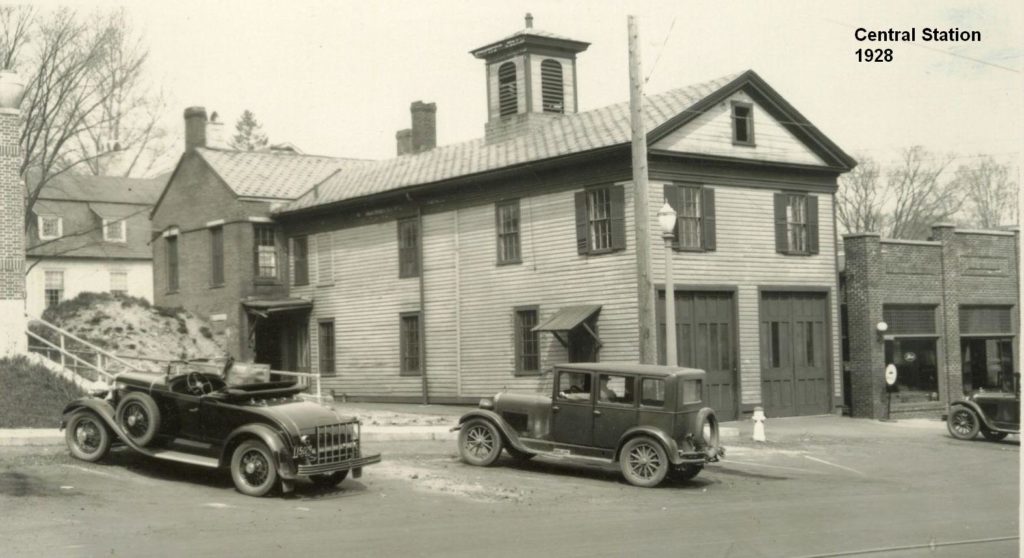

In North Amherst, there was a town-funded Fire Station, with a three-story hose tower, built on Pine Street in around 1920; it is now a private home.
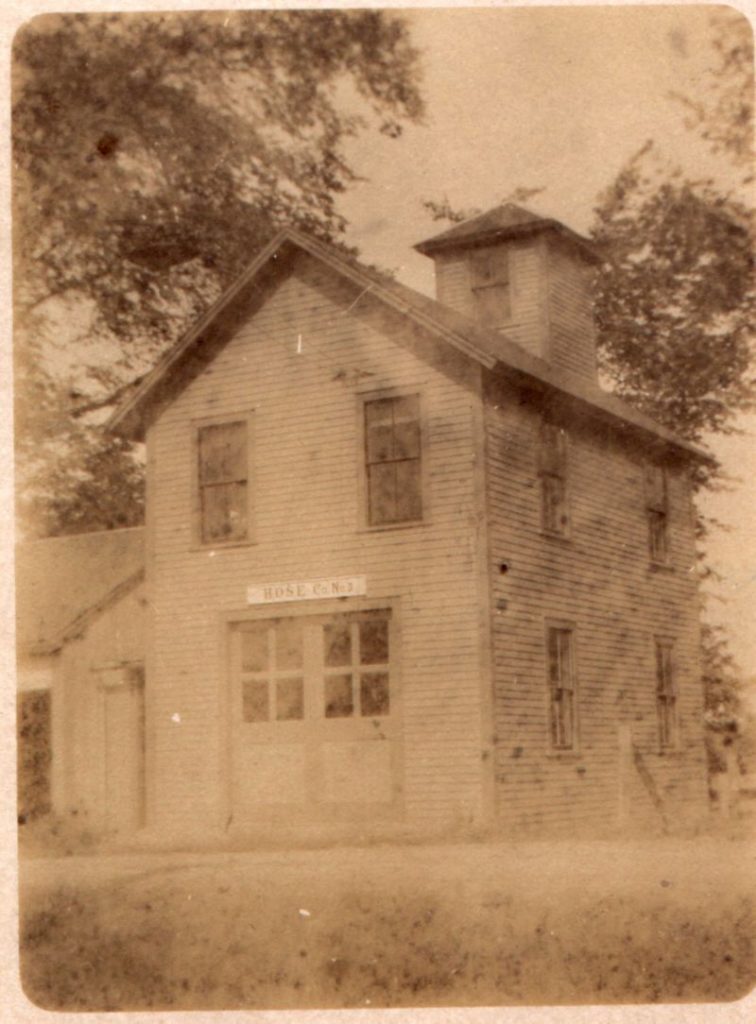
The new North Amherst station, located close to UMass’s campus, on Eastman Lane, was not built until 1975 in the Brutalist style. A wonderful article from the Amherst Bulletin shows two retiring members outside this station before the pandemic when Fire Chief Nelson was in charge.
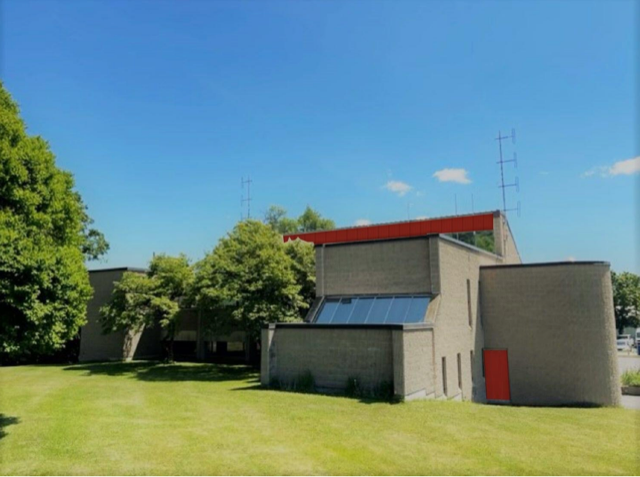
With the passing of the country’s Bipartisan Crime Bill in 1994, our town began to create the conditions for a purpose- built police department. It was to be sited on Main St, downhill from Town Hall and close to the Masonic Hall and the First Congregational Church. It was designed by Kuhn Riddle and finished in 2001. It takes its design cues directly from Town Hall and also includes an expansive low-pitched roof to the side, which suggests modernist Scandinavian Arts and Crafts ‘folk’ building styles.

Aside from issues of criminal justice, our police department now takes responsibility for a host of other issues apart from the ones already mentioned; animal welfare (and the town pound), traffic concerns, parking, community outreach, training, crisis services (now partly accommodated by CRESS but not yet outside of office hours), record keeping, and detective work. Before the pandemic, in 2018, there were 20,000 service calls. Amherst’s Fire and Police departments are still somewhat combined as the Amherst Communication Center for emergency dispatch is located on the third floor of the Amherst Police Station on Main Street.

Appreciating the history of the built environment in our town is a kind of learned behavior and I realize that I have given the Department of Public Works short shrift here. It has also outgrown its site and requires something larger and no doubt more ecologically designed to accommodate many needs in town. To appreciate our historic public buildings is to appreciate some of our local, regional, even national history: we enter into a building’s ‘bigger story’ and finding out who worked in specific buildings, or who designed them. Members of our families may have worked there. It might involve evaluating how certain building types evolved at a particular point in history. It goes without saying that with public safety and public services, our officials who worked/work there do so ideally for all of the town’s citizens and are responsible to our elected government, not to any one political party. They deliver programs or services, inform policy-making, and provide evidence-based advice to our leaders. It is no small task and thanking our emergency public service workers needs to continue.
Amherst’s Town Hall has evolved over time to contain many services apart from its police department but it also symbolizes other functions as well. It displays many different flags from around the world throughout the year as we celebrate our world; it offers space for holding public meetings. The front steps are wide up to the main door (although not universally accessible so that has been addressed) and the intention is to look grand but open to all. There have been adaptations and accommodations that have been made over time as well as necessary maintainence. The large sandstone building looks like something from the old world, sitting on a deep stone foundation and a small berm that helps the illusion that the building towers over the North Common and the streets around it. You can see how these streets gently dip down to the valley and to North, East and South Amherst. It is a great choice in terms of siting (even though Amherst College is higher) and a potent symbol of our town. I have its image on my bank debit card.
But perhaps you have other emotional responses when looking at Town Hall that are stirred by our representatives, our roads, our tax structure or budget challenges? Do you look forward to the changes coming to the public common outside Town Hall or not? Does the building feel unassailable, ancient or rock-like, built as it is from regional sandstone quarries? Does that make for an appearance of solidity and strength or timelessness? Or does it suggest longevity based on its style alone, recalling original Romanesque buildings from Europe in the 10th and 11th centuries? Maybe it means something else to you personally?
The building’s design in the Romanesque Revival style was intended to stir civic pride. Some people would argue that the building itself is a work of art that could not now be replicated because of the cost per square foot for such a wide range of materials, motifs, and features that would be prohibitive. And not LEED certifiable which is an important consideration today. The grand main staircase and council chamber/meeting room were compelling statements about public discourse at the time as the country struggled to enlarge suffrage, embody dignity and respect for public service and public institutions. Such discussions continue in our search for the greater good and a more perfect union.

Many apologies to Tim Nelson (as I am hearing him on a webinar call at this very moment). Asst. Chief Lindsay Stromgren is usually the person I see representing the dept. Again, Chief Nelson is still serving – so here would be my embarrassed face emoji.